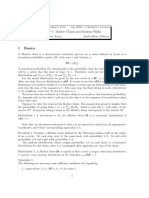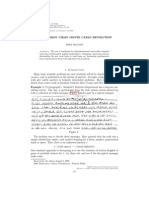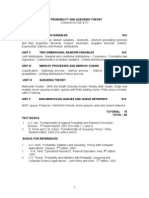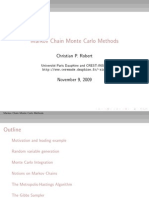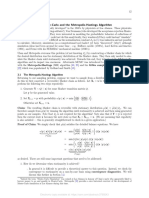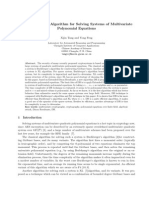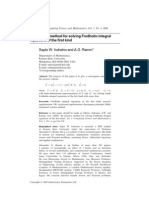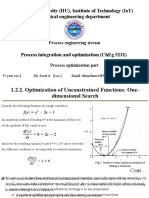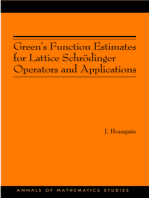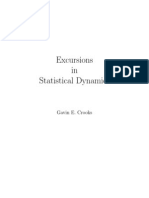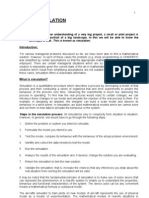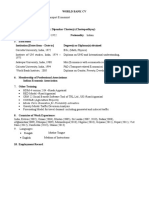On The Markov Chain Monte Carlo (MCMC) Method: Rajeeva L Karandikar
On The Markov Chain Monte Carlo (MCMC) Method: Rajeeva L Karandikar
Uploaded by
Diana DilipCopyright:
Available Formats
On The Markov Chain Monte Carlo (MCMC) Method: Rajeeva L Karandikar
On The Markov Chain Monte Carlo (MCMC) Method: Rajeeva L Karandikar
Uploaded by
Diana DilipOriginal Title
Copyright
Available Formats
Share this document
Did you find this document useful?
Is this content inappropriate?
Copyright:
Available Formats
On The Markov Chain Monte Carlo (MCMC) Method: Rajeeva L Karandikar
On The Markov Chain Monte Carlo (MCMC) Method: Rajeeva L Karandikar
Uploaded by
Diana DilipCopyright:
Available Formats
S adhan a Vol. 31, Part 2, April 2006, pp. 81104.
Printed in India
On the Markov Chain Monte Carlo (MCMC) method
RAJEEVA L KARANDIKAR
7, SJS Sansanwal Marg, Indian Statistical Institute, New Delhi 110 016, India
e-mail: rlk@isid.ac.in
Abstract. Markov Chain Monte Carlo (MCMC) is a popular method used to
generate samples from arbitrary distributions, which may be specied indirectly.
In this article, we give an introduction to this method along with some examples.
Keywords. Markov chains; Monte Carlo method; random number generator;
simulation.
1. Introduction
In this article, we give an introduction to Monte Carlo techniques with special emphasis on
Markov Chain Monte Carlo (MCMC). Since the latter needs Markov chains with state space
that is R or R
d
and most text books on Markov chains do not discuss such chains, we have
included a short appendix that gives basic denitions and results in this case.
Suppose X is a random variable (with known distribution, say with density f ) and we are
interested in computing the expected value
E[g(X)] =
_
g(x)f (x)dx (1)
for a given function g. If the functions f, g are such that the integral in (1) cannot be computed
explicitly (as a formula for the indenite integral may not be available in closed form) then
we can do as follows.
Assuming that we can generate a random sample from the distribution of X, generate a
random sample of size n:
x
1
, x
2
. . . x
n
,
from this distribution and compute
a
n
=
1
n
n
i=1
g(x
i
).
Then by the law of large numbers, a
n
approximates E[g(X)].
Moreover, the central limit theorem gives the order of error; the error here is of the order of
O(n
1
2
).
81
82 Rajeeva L Karandikar
As of nowwe have not said anything about the randomvariable X it could be taking values
in Ror R
d
for any dimension d. The important thing to note is that the order of error does not
depend upon the dimension. This is very crucial if d is high as most of the numerical analysis
techniques do not fare well in higher dimension. This technique of generating x
1
, x
2
, . . . x
n
to
approximate quantities associated with the distribution of X is called Monte Carlo simulation
or just Simulation.
The most crucial part of the procedure described above is the generation of a randomsample
from the distribution of X. We deal here with the case where the state space is a subset of R
or R
d
and the distribution is given by its density f .
We assume that we have access to a good randomnumber generator which gives us a way
of generating a randomsample fromUniform(0,1). For example, one could use the Mersenne
Twister random number generator (see http://www.math.keio.ac.jp/matumoto/emt.html).
There is a canonical way of generating a univariate randomvariable fromany distribution F:
Let F
1
be the inverse of F and let U be a sample from Uniform (0,1). Then X = F
1
(U)
is a random sample from F.
Often, the distribution is described by a density and a closed form for the distribution func-
tion F is not available, and so the method described above fails. Another method is trans-
formation of variables: Thus, if we have a method to generate N(0, 1) random variables,
then to generate a sample from t distribution with k degrees of freedom, we can generate
independent samples X, Y
1
, . . . , Y
k
from N(0, 1) and then take
t = X
_
_
k
j=1
Y
2
j
/k
_
1/2
Indeed, the common method to generate samples from N(0, 1) also uses the idea of trans-
formation of variables: Generate U, V from Unifrom (0,1), U, V independent) and dene
X = [2 log(U)]
1/2
cos(2V)
Y = [2 log(U)]
1/2
sin(2V).
Then X, Y are independent samples from N(0, 1).
Of course, transformation of variables is a powerful method, but given a distribution, it is
not clear how to use this method. So even when density is known we may have difculty in
generating samples from the distribution corresponding to it.
There are many situations where f may not be explicitly known but is described indirectly.
For example, f may be known only upto a normalizing constant. Another possibility is that the
distribution of interest is a multivariate distribution that is not known, but all the conditional
distributions are specied.
Suppose we know f
1
(x) = Kf (x) but do not explicitly know K. Of course, K equals
the integral of f
1
. Numerically computing K and then proceeding to numerically compute
_
g(x)f (x)dx can inate the error. It would be much better if just knowing f
1
, we can device
a scheme to generate randomsample fromf = (1/K)f
1
and thereby compute
_
g(x)f (x)dx
approximately.
Bayesian framework: Suppose that given , X has a density p(x | ) and the prior on is
given by a density (). Then the posterior density ( | x) of given an observation X = x
is given by
( | x) = [p(x | )()]
___
p(x | )()d
_
.
On the Markov Chain Monte Carlo (MCMC) method 83
Often it is difcult to obtain exact expression for
_
p(x | )()d,
but given p(x | ), () we know ( | x) upto a normalizing constant!
Note that once there is a method to generate samples from the posterior density, there is no
need for a practitioner to restrict the choice of prior to a conjugate prior (roughly, these are
priors for which the the posterior can be computed in closed form). Even though the posterior
density of may not be available in closed form, all quantities of interest could be obtained
by simulation.
2. Rejection sampling
In 1951 von Neumann gave a method to generate samples from a density f = (1/K)f
1
knowing only f
1
if there is a density h such that (it is possible to generate samples fromh and)
f
1
(x) Mh(x) x.
The algorithm, given below, is known as rejection sampling.
(1) Generate a random sample from the distribution with density h. Let it be y.
(2) Accept y as the sample with probability [f
1
(y)/Mh(y)].
(3) If step (2) is not a success, then go to step (1).
Here f (or f
1
) is called the target density and h(x) is called a majorizing function or an
envelope or in some contexts the proposal density. We can repeat the steps (1)(3) several
times to generate i.i.d. samples from f .
The algorithmcanbe describedas follows (as pseudo-code). (Here andinthe sequel, succes-
sive calls to the random number generator are assumed to yield independent observations.)
The following algorithm generates a random sample z
1
, . . . , z
N
from the distribution f .
Rejection sampler algorithm:
i = 0
do
{
i = i +1
k = 0
do
k = k +1;
Generate u
k
from Uniform (0,1) and x
k
from h
} while
_
u
k
>
f
1
(x
k
)
Mh(x
k
)
_
z
i
= x
k
} while i N
We will now prove that the algorithm described above yields a random sample from f .
84 Rajeeva L Karandikar
Theorem 1 (Rejection sampling). Suppose we are given f
1
, such that f
1
(x) = Kf (x) for
a density f . Suppose there exists a density h(x) and a constant M such that
f
1
(x) Mh(x) x. (2)
Let X
k
be i.i.d. with common density h, U
k
be i.i.d. Uniform (0,1). Let B be given by
B = {(x, u) : u f
1
(x)/Mh(x)}
and be the rst m such that (X
m
, U
m
) B and let W = X
. Then W has density f .
Proof. Take Z
k
= (X
k
, U
k
). Note that
P( = m) = P(Z
1
/ B, . . . Z
m1
/ B, Z
m
B)
= P(Z
1
/ B)
m1
P(Z
m
B)
= (1 P(Z
1
B))
m1
P(Z
1
B),
and hence P( < ) = 1. Now
P(Z
m
A | = m) = P(Z
m
A | Z
1
/ B, . . . Z
m1
/ B, Z
m
B)
= P(Z
m
A | Z
m
B)
= P(Z
1
A | Z
1
B),
and hence
P(Z
A) =
m
P(Z
m
A | = m)P( = m)
=
m
P(Z
1
A | Z
1
B)P( = m)
= P(Z
1
A | Z
1
B).
Taking A = (, a] [0, 1] for a R, we have (using {Z
A} = {W a}),
P(W a) = P(X
1
a | Z
1
B)
=
P(X
1
a, Z
1
B)
P(Z
1
B)
=
__
a
_
1
0
1
B
(x, u)h(x)dudx
____
_
1
0
1
B
(x, u)h(x)dudx
_
=
__
a
f
1
(x)
Mh(x)
h(x)dx
____
f
1
(x)
Mh(x)
h(x)dx
_
=
__
a
f
1
(x)dx
____
f
1
(x)dx
_
=
_
a
f (x)dx.
On the Markov Chain Monte Carlo (MCMC) method 85
We have used
_
1
0
1
B
(x, u)du = f
1
(x)/Mh(x) and also that f
1
is proportional to the density
f . This completes the proof.
Let us examine what happens if we use the rejection sampling algorithmwhen the envelope
condition (2) is not true:
The integral
_
a
_
1
0
1
B
(x, u)h(x)dudx now equals,
_
a
min
_
f
1
(x)
Mh(x)
, 1
_
h(x)dx,
which simplies to
_
a
1
M
min(f
1
(x), Mh(x))dx.
Thus the density of the output W is proportional to,
f
1
(x) = min(f
1
(x), Mh(x)),
rather than to f
1
(x).
Rejection method is a good method if a suitable envelope can be found for the target
density. Suppose the target density is f (x) and f
1
(x) = Kf (x) is known. Suppose g(x) is
the proposal or majorizing density and suppose that
f (x) Mg(x),
(so that f
1
(x) KMg(x)). The probability of accepting a sample is (1/M) and the distri-
bution of number of trials needed for one acceptance is geometric. Thus, on the average M
trials would be needed for accepting one sample. This can be a problem if M is large.
3. Markov Chain Monte Carlo
The Monte Carlo methods discussed above were based on generating independent samples
from the specied distribution. Metropolis and others in a paper published in Journal of
Chemical Physics in 1953 use a very different approach for simulation. The paper deals with
computation of certain properties of chemical substances, and uses Monte Carlo techniques
for the same but in a novel way:
For the distribution of interest whose density is , they construct a Markov Chain {X
n
} in
such a way that the given distribution is the stationary distribution for the chain. The chain
constructed is aperiodic and irreducible so that the stationary distribution is unique. Then the
ergodic theorem ensures that
1
N
N
n=1
g(X
n
)
_
g(x)(x)dx,
as N . This can be used to estimate
_
g(x)(x)dx.
Given a distribution how does one construct a Markov Chain with as the stationary
distribution?
86 Rajeeva L Karandikar
The answer to this question is surprisingly simple. We begin with a simple example. The 3-
dimensional analogue of this example was introduced in statistical physics to study behaviour
of a gas whose particles have non-negligible radii and thus cannot overlap.
Consider an N N chessboard. Each square is assigned a 1 or 0.
1 means the square is occupied and 0 means that the square is unoccupied. Each such
assignment is called a conguration. Aconguration is said to be feasible if all the neighbours
of every square that is occupied are unoccupied. (Every square that is not in the rst or last
row or column has 8 neighbours.)
Thus a conguration is feasible if for every pair of adjacent squares, at most one square
has a 1.
For a feasible conguration (denoted by ), let n() denote the number of 1s in . The
quantity of interest to physicists is the average of n() where the average is taken over the
uniform distribution over all the feasible congurations.
The total number of congurations is 2
NN
and even when N = 25, this number is 2
625
,
thus it is not computationally feasible to scan all congurations. Hence, count the feasible
congurations and take the average of n().
Assume that a powerful computer can sequentially scan the congurations , decide if it is
feasible and, if so, count n() in one cycle, and suppose the clock speed is 1000 GHz. Sup-
pose there are a million such machines working in parallel. Then in one second, 2
10+30+20
=
2
60
congurations will be scanned. In one year, there are 243600365 = 31536000 which
is approximately 2
25
= 33554432 seconds. Thus, we can scan 2
85
congurations in one year,
when we have a million computers working at 1000 GHz speed. It will still take 2
540
years.
Even if the size is 10, the number of congurations is 2
100
and it would take 2
15
= 32768
years.
It is easy to see that when N = 25, the total number of feasible congurations is at least
2
169
. To see this, assign 0 to all squares that have one of the coordinates even (the squares are
indexed from 1 to 25). In the remaining 169 positions, we can assign a 1 or 0. It is clear that
each such conguration is feasible and the total number of such congurations is 2
169
.
Let denote the discrete uniform distribution on the set of feasible congurations:
() = 1/M,
where M is the total number of feasible congurations. We construct a Markov Chain {X
k
}
on the set of feasible congurations in such a way that it is aperiodic and irreducible and
is the stationary distribution for the chain.
Then as N
1
N
N
k=1
n(X
k
)
n()().
The transition function p(, ) is described as follows: Fix 0 < p < 1. Given a feasible
conguration , choose a square s (out of the N
2
squares) with equal probability. If any of
the neighbours of s is occupied (has 1) then = ; if all the neighbours of s are unoccupied
(have 0) then with probability p, ip the state of the square s and otherwise do nothing.
(Since the chain is slow moving, it would be better to take p close to 1.)
Let us observe that the chain is irreducible. First note that the transition function is sym-
metric:
p(, ) = p(, ).
On the Markov Chain Monte Carlo (MCMC) method 87
If , differ at more than one square, then the above equality holds as both the probabilities
are zero. The same is true if they differ at one square, then all the adjacent squares must have
0 and then both the terms above are
p/(N N).
Thus the transition function is symmetric.
Thus to prove that the chain is irreducible sufces to prove that the null conguration
(where every square has a 0) leads to any other square. If a conguration has exactly one 1
then it is clear that it can be reached from the null conguration in one step. It follows that
any feasible conguration can be reached from null conguration in n() steps. Hence, the
chain is irreducible.
Since p(, ) > 0 for every feasible , it follows that the chain is aperiodic. Thus the chain
is a nite state Markov Chain that is irreducible and aperiodic. Hence it is positive recurrent
and admits a unique stationary distribution. Note that
()p(, ) =
1
M
p(, )
=
1
M
p(, )
=
1
M
= ().
Thus is the unique stationary distribution.
Hence as L ,
1
L
L
k=1
n(X
k
)
n()(), (3)
where {X
k
} is the Markov Chain described above. Thus to approximate
n()(), we
can choose a large L and take (1/L)
L
k=1
n(X
k
) as an approximation. Even better, to reduce
dependence on initial state X
0
,we can rst choose J, L integers, and then take
1
L
J+L
k=J+1
n(X
k
)
as an approximation for
n()().
Thus by generating the Markov Chain as described above, we can estimate the average
number of occupied sites. This is an example of the MCMC technique.
How large should J, L be for
1
L
J+L
k=J+1
n(X
k
)
to give a good approximation to
n()()?
Consider a simple random walk on N = 2
100
points placed on a (large) circle, so that
p
ij
= 05 if j = i +1 mod (N) or j = i 1 mod (N),
88 Rajeeva L Karandikar
and zero otherwise. Here also, the chain is irreducible and the transition probability matrix
is doubly stochastic and thus the unique invariant probability distribution is the uniform
distribution on the N points. Let h be a function on {0, 1, 2, . . . , N1} and X
n
be the Markov
Chain. Since in L steps, this Markov Chain will at most move L steps to the right and L steps
to the left, (and with very high probability, does not go more than 10
L steps away from
X
0
), it is clear that L must be much larger than N for the ergodic average
1
L
J+L
k=J+1
h(X
k
),
to be a good approximation of
1
N
N1
j=0
h(j).
Therefore, in this case, the MCMC technique does not yield a good answer.
One has to be careful in choosing an appropriate L. As a thumb rule, let M be the smallest
integrer such that
P(X
M
= j | X
0
= i) > 0 states i, j.
Then J should be of the order of M and Lshould be much larger. In the chessboard example
with N = 25, we can see that M 2 169.
In the chessboard example with N = 25, what J, L would sufce? To see this, we can
generate the Markov Chain and compute the approximation several times, say 1000 times,
and compute the variance of the estimate for various choices of J, L (table 1).
It can be seen that J = 1000 and L = 100000 gives a very good approximation.
Table 1. Monte Carlo results for Uniform distribution.
J L Mean Variance
1000 1000 89618 717764
1000 2000 898109 36315
1000 4000 899856 231912
1000 5000 900753 179497
1000 10000 902991 0918608
1000 20000 903284 0475608
1000 40000 90389 0243295
1000 50000 904042 021296
1000 100000 904365 00999061
1000 200000 904486 00527094
1000 400000 904464 00261528
1000 500000 904449 00207095
1000 1000000 904499 000986929
1000 2000000 904519 000535309
1000 4000000 904486 000245182
1000 5000000 904506 000195814
1000 10000000 904515 000104744
On the Markov Chain Monte Carlo (MCMC) method 89
What if for the chessboard example we were interested in computing
n()(),
with stationary invariant distribution () that is no longer the uniform distribution, but
another distribution say
() = c exp{Kn()}
where K is a constant and c is normalising constant.
One possibility is to estimate c
1
by (for suitable J, L),
J+L
k=J+1
exp{Kn(X
k
)},
and then estimate
n() exp{Kn()} by
J+L
k=J+1
n(X
k
) exp{Kn(X
k
)},
so that the required approximation is
_
J+L
k=J+1
n(X
k
) exp{Kn(X
k
)}
_
_
_
J+L
k=J+1
exp{Kn(X
k
)}
_
.
Here again, we can generate the estimate for J, L several times and compute the variance
of the estimate (table 2).
Table 2. Monte Carlo results for Gibbs distribution: Ratio Method.
J L Mean Variance
1000 1000 822744 124061
1000 2000 806866 893338
1000 4000 794026 799263
1000 5000 789912 755298
1000 10000 78055 626682
1000 20000 768683 564003
1000 40000 759593 479803
1000 50000 756392 437511
1000 100000 746713 481159
1000 200000 739778 399164
1000 400000 731445 385673
1000 500000 729314 38598
1000 1000000 722698 381293
1000 2000000 716584 349804
1000 4000000 710077 354857
1000 5000000 708849 33355
1000 10000000 70304 360938
90 Rajeeva L Karandikar
Here, we can see that the variance of the estimate does not go down as expected, even when
we take L = 1000000 and more.
Instead, can we construct a Markov Chain {X
n
} whose invariant distribution is () so
that (3) is valid?
Let p(, ) denote the transition function described in the earlier discussion. Recall that
it is symmetric.
Let
(, ) = min
_
1,
()
()
_
.
Dene
q(, ) = p(, )(, ),
if = and
q(, ) = 1
=
q(, ).
For congurations , , if () (),
q(, ) = p(, ),
and
q(, ) = p(, )[()/()],
and hence
()q(, ) = ()q(, ). (4)
By interchanging roles of , , it follows that (4) is true in the other case: () () as
well. As a consequence of (4), it follows that is an invariant distribution for the transition
function q. (Equation (4) is known as the detailed balance equation.) Since p is irreducible,
aperiodic, it follows that so is q and hence that is the unique invariant measure and that the
q chain is ergodic (table 3).
Observe that here the variance reduces as expected and the mean is very stable for L =
100000 as in the uniform distribution case. Thus we have reason to believe that this method
gives a good approximation while the earlier method is way off the mark even with L =
10000000.
This construction shows that given any symmetric transition kernel p(, ) such that the
underlying Markov Chain is an irreducible aperiodic chain which is easy to simulate from
p(, ), we can create a transition kernel q for which the stationary invariant distribution is .
As we will see, it is easytosimulate fromq(, ) - rst we simulate a move fromthe distribution
p(, ) (to say ) and then accept the move with probability (, ), otherwise we stay
put at . As in rejection sampling, the move with probability (, ) is implemented by
simulating an observation, say u, fromuniform(0,1) distribution and then accepting the move
if u < (, ), otherwise, not to move from in that step.
Let us now move to continuous case (see Robert & Casella 1999; Roberts & Rosenthal
2004). For now, let us look at real valued random variables. Again, we are given a target
On the Markov Chain Monte Carlo (MCMC) method 91
Table 3. Monte Carlo results for Gibbs distribution: MCMC technique.
J L Mean Variance
1000 1000 663028 91541
1000 2000 664575 576939
1000 4000 664792 293947
1000 5000 66625 256194
1000 10000 665286 136421
1000 20000 666623 0678447
1000 40000 666348 0326311
1000 50000 666676 0267248
1000 100000 666442 0127588
1000 200000 666476 00629443
1000 400000 666632 00309451
1000 500000 6666 00256965
1000 1000000 666581 00138524
1000 2000000 666539 000687151
1000 4000000 66655 000344363
1000 5000000 666546 000289359
1000 10000000 666586 000133429
function f
1
(x) = Kf (x) with f being a density, K is not known and we want to generate
samples fromf . The starting point is to get a Markov Chain with good properties (irreducible,
aperiodic) with the probability transition density function q(x, y) (assumed to be symmetric,
and such that it is possible to simulate from q(x, ) for every x. q is called the proposal).
Then dene (as in the nite case)
(x, y) = min{1, f
1
(y)/f
1
(x)},
(with the usual convention: (x, y) = 0 if f
1
(y) = 0 and (x, y) = 1 if f
1
(y) > 0 but
f
1
(x) = 0) and then
p(x, y) = q(x, y)(x, y).
It is easy to check that
(x, y)/(y, x) = f
1
(y)/f
1
(x),
and hence that the detailed balance equation holds:
f (x)p(x, y) = f (y)p(y, x) x, y. (5)
We can nowdene a Markov Chain {X
n
} that has f as its stationary distribution as follows:
Given that X
n
= x, the chain does not move (i.e., X
n+1
= x) with probability 1(x) where
(x) =
_
p(x, y)dy
and given that it is going to move, it moves to a point y chosen according to the density
p(x, y)/(x).
92 Rajeeva L Karandikar
The transition kernel P(x, A) for this chain is given by, for a bounded measurable function g
_
g(z)P(x, dz) = (1 (x))g(x) +
_
g(z)p(x, z)dz. (6)
This can be implemented as follows: given X
k
= x, we rst propose a move to a point y
chosen according to the law q(x, ) and then choose u according to the Uniform distribution
on (0, 1) and then set X
k+1
= y if u < (x, y) and X
k+1
= x if u (x, y). Once again we
can verify the detailed balance equation
f (x)p(x, y) = f (y)p(y, x) x, y,
and hence (on integration w.r.t. x) it follows that
_
f (x)p(x, y)dx = (y)f (y), (7)
and hence using (6), (7) and Fubinis theorem we can verify that
_ __
g(z)P(x, dz)
_
f (x)dx =
_
(1 (x))g(x)f (x)dx
+
_ __
g(y)p(x, y)dy
_
f (x)dx
=
_
(1 (x))g(x)f (x)dx
+
_
g(y)(y)f (y)dy
=
_
g(y)f (y)dy.
Thus, f (x) is the density of a stationary invariant distribution of the constructed Markov
Chain. Note that here the transition probability function is a mixture of a point mass and a
density w.r.t. the Lebesgue measure.
Let us note that in the procedure described above, if f
1
(X
k
) > 0 then f
1
(X
k+1
) > 0 and
hence if we choose the starting point carefully (so that f
1
(X
0
) > 0), we move only in the
set {y : f
1
(y) > 0}. Usually, the starting point X
0
is chosen according to a suitable initial
distribution.
We can choose the proposal chain in many ways. One simple choice: Take a continuous
symmetric density q
0
on R with q
0
(0) > 0 and then dene
q(x, y) = q
0
(y x).
The chain {W
n
} corresponding to this is simply the random walk where each step is chosen
according to the density q
0
, which is chosen so that it has a nite mean (which then has
to be zero since q
0
is symmetric) and such that efcient algorithm is available to generate
samples from q
0
. We also need to specify a starting point, which could be chosen according
to a specied density g
0
.
On the Markov Chain Monte Carlo (MCMC) method 93
The resulting procedure is known as the MetropolisHastings RandomWalk MCMC. Here
is the algorithm as a psuedo-code: to simulate {X
k
: 0 k N}
(1) Generate X
0
from the distribution with density q
0
and set n = 0;
(2) n = n +1;
(3) generate W
n
from the distribution with density q
0
;
(4) Y
n
= X
n
+W
n
proposed move;
(5) generate U
n
from uniform (0,1);
(6) if U
n
f
1
(X
n
) f
1
(Y
n
), then X
n+1
= Y
n
, otherwise X
n+1
= X
n
;
(7) if n < N, go to (2) else stop.
Then the generated Markov Chain {X
k
: 0 k N} has f as its stationary distribution.
Like in the discrete case, here too for a function g such that
_
|g(x)|f (x)dx
lim
N
1
N
N
i=1
g(X
i
) =
_
g(x)f (x)dx.
However, since the aim is to approximate the integral based on a nite sample, we ignore an
initial segment of the change with the hope that the distribution of the chain may be closer
to the limiting distribution. Also, in order to reduce dependence between successive values
(we are going to have lots of instances where the chain does not move), one records the chain
after suitable Gap G. Thus we record
Z
k
= X
B+kG
,
for suitable Burn In B, Gap G for k = 1, 2, . . . L and then use
1
N
N
i=1
g(Z
i
),
as an approximation to
_
g(x)f (x)dx.
Example: Target is a mixture of two normals, with equal weights,
f
1
(x) = exp{(x 4)
2
/8} +exp{(x 16)
2
/8}.
This is bi-modal, with the two distributions having almost disjoint supports. The mean of f
is 10 and variance is 40 (so that standard deviation is 6324).
The random walk proposal distribution is taken as double exponential with parameters
0,1 (we must ensure that the mean of the proposal is 0), the burn in is taken as 5000, gap
as 50. We generate 10 samples of size 10000 and the mean, standard deviation and variance
in each of the sample is given in table 4.
The above algorithm is an adaptation of the Metropolis algorithm. Hastings in 1970 sug-
gested a modication that does not require the proposal kernel to be symmetric. This allows
us to consider the proposal chain to be an i.i.d sequence. Thus the chain is just a sequence
94 Rajeeva L Karandikar
Table 4. Monte Carlo results for Mixture of Normal distributions.
Mean SD VAR
10173955 6283718 39485116
9719518 6317257 3990773
9783166 6326743 4002768
9799898 6300697 39698783
10124491 6308687 39799526
10100052 6326426 40023664
9309102 6297279 39655727
10258374 6322546 39974584
9819395 63241 39994238
10204787 6303478 39733837
of independent random variables W
n
with common distribution having a density q
1
and take
the transition function as
q(x, y) = q
1
(y).
The multiplier (x, y) is now given by the formula
(x, y) = min{1, [f
1
(y)q
1
(x)]/[f
1
(x)q
1
(y)]},
and the transition kernel p(x, y) is given by
p(x, y) = q(x, y)(x, y).
As in the randomwalk case, we can dene a Markov Chain {X
n
} that has f as its stationary
distribution as follows.
Given that X
n
= x, the chain does not move (i.e. X
n+1
= x) with probability 1 (x)
where
(x) =
_
p(x, y)dy,
and given that it is going to move, it moves to a point y chosen according to the density
p(x, y)/(x).
This can be implemented as follows: given X
k
= x, we rst propose a move to a point y
chosen according to the law q(x, ) and then choose u according to the uniform distribution
on (0, 1) and then set X
k+1
= y if u < (x, y) and X
k+1
= x if u (x, y). Once again we
can verify the detailed balance equation
f (x)p(x, y) = f (y)p(y, x) x, y,
and as in the random walk case, it follows that f (x) is the density of a stationary invariant
distribution of the constructed Markov Chain. Note that here the transition probability function
is a mixture of a point mass and an absolutely continuous density.
On the Markov Chain Monte Carlo (MCMC) method 95
MetropolisHastings independence chain: Here is the algorithm as a psuedo-code: to sim-
ulate {X
k
: 0 k N}
(1) Generate X
0
from the distribution with density q
0
and set n = 0;
(2) n = n +1;
(3) generate W
n
from the distribution with density q
0
;
(4) Y
n
= W
n
proposed move;
(5) generate U
n
from uniform (0,1);
(6) if U
n
f
1
(X
n
)q
1
(Y
n
) f
1
(Y
n
)q
1
(X
n
), then X
n+1
= Y
n
otherwise X
n+1
= X
n
;
(7) if n < N, go to (2) else stop.
Then the generated Markov Chain {X
k
: 0 k N} has f as its stationary distribution.
When we have two Markov chains with the same stationary distribution, we can generate
yet another chain where at each step we move according to one chain say with probability
05 and the other chain with probability 05.
This has an advantage that if for the given target, even if one of the two chains is well
behaved then the hybrid chain is also well behaved.
How does the algorithm behave for fat-tailed distributions?
We ran the programme (Hybrid version) for Cauchy and found that even with 50000 sample
size, burn in of 50000 and Gap of 20; the results were not encouraging. And this when the
Cauchy distribution is taken with median 0, and the proposal and RW proposal also have
mean 0 (double exponential (0,8) and Uniform (5, 5) respectively).
To see if burn in and gap (same sample size) improves the situation, we ran the hybrid
algorithm with a burn in of 50,000,000 and a gap of 10000. Five samples each of size 50000
meant a total of 2,750,000,000. This took 7293 seconds (little more than 2 hours).
Also, with burn in of 50,000,000 and gap of 20000, total samples generated were
5,250,000,000 (over 5 billion). The time taken was a little under 4 hours.
With both these runs, the outputs seemto be stable. It appears that for fat-tailed distribution,
we need large burn in and large gap.
Gibbs sampler
Suppose it is given that X, Y are real-valued random variables such that the conditional
distribution of Y given X is normal with mean 03Y and variance 4 and the conditional
distribution of X given Y is normal with mean 03X and variance 4. Does this determine the
joint distribution of X, Y uniquely?
More general question: Let (x, y) be the joint density of X, Y; f (y; x) be the conditional
density of Y given X = x and g(x; y) be the conditional density of X given Y = y. Do
f (y; x), g(x; y) determine (x, y) ?
Consider the one-step transition function P((x, y), A) with density
h((u, v); (x, y)) = f (v; x)g(u; v).
This corresponds to the following: starting from (x, y), rst update the second component
from y to v by sampling from the distribution with density f (v; x) and then update the rst
component from x to u by sampling from the distribution with density g(u; v).
Let us note that if f
, g
denote the marginal densities of X, Y respectively, then
f (y; x) = [(x, y)]/[f
(x)], g(x; y) = [(x, y)]/[g
(y)],
96 Rajeeva L Karandikar
and hence
_ _
h((u, v); (x, y))(x, y)dydx =
_ _
f (v; x)g(u; v)(x, y)dydx
=
_
f (v; x)g(u; v)
__
(x, y)dy
_
dx
=
_
f (v; x)g(u; v)f
(x)dx
=
_
g(u; v)(x, v)dx
= g(u; v)g
(v)
= (u, v).
Nowif f (y; x) and g(x; y) are continuous and (strictly) positive for all x, y, then this chain
is irreducible and aperiodic (see appendix for denition) and has a stationary distribution
(x, y) which must then be unique.
This answers the question posed above in the afrmative. Further, if we have algorithms to
generate samples from the univariate densities f (y; x) and g(x; y), this gives an algorithm to
(approximately) generate samples from (x, y) run the chain for a sufciently long time.
This is an MCMC algorithm.
Note that we could have instead taken
h((u, v); (x, y)) = f (v; u)g(u; y),
or
h((u, v); (x, y)) = 05(f (v; x)g(u; v) +f (v; u)g(u; y)).
In either case, the resulting Markov Chain would have (x, y) as its stationary invariant
distribution.
This can be easily generalized to higher dimensions. The resulting MCMC algorithm is
knownis Gibbs sampler that is useful insituations where we want tosample froma multivariate
distribution which is indirectly specied- the distribution of interest is a distribution on R
d
(for d > 1) and it is prescribed via its full conditional distributions.
Let X = (X
1
, X
2
, . . . , X
d
) have distribution and x = (x
1
, x
2
, . . . x
n
). Let
X
i
= (X
1
, X
2
, . . . X
i1
, X
i+1
. . . , , X
d
)
x
i
= (x
1
, x
2
, . . . , x
i1
, x
i+1
, . . . , x
n
).
The conditional density of X
i
given X
i
= x
i
is denoted by
f
i
(x
i
; x
i
).
As in the case when n = 2, the collection {f
i
: 1 i d} completely determines
if each f
i
is a strictly positive continuous function. It should be noted that if instead of the
full conditional densities f
i
(conditional density of ith component given all the rest), the
On the Markov Chain Monte Carlo (MCMC) method 97
conditional densities of the ith component, given all the preceding components, is available
for i = 2, 3, . . . d along with the density of the rst component, then it is easy to simulate a
sample: rst we simulate X
1
, then X
2
and so on till X
d
.
If we only know f
i
, 1 i n, Gibbs sampler is an algorithm to generate a sample from
. In d-dimensions, we can either update the d components sequentially in some xed order
or at each step choose one component (drawing from uniform distribution on {1, 2, . . . d}).
Let x = (x
1
, x
2
, . . . x
d
) be a point from the support of the joint distribution. Set X
0
= x.
Having simulated X
1
, X
2
, . . . X
n
, do the following to obtain X
n+1
(1) choose i from the discrete uniform distribution on {1, 2, . . . , d};
(2) simulate w from the conditional density f
i
(x
i
; X
n
i
);
(3) set X
n+1
i
= w and X
n+1
j
= X
n
j
, for j = i.
Note that at each step, only one component is updated. It can be shown that the Markov
Chain has as its unique invariant measure and hence for large n, X
n
can be taken to be a
sample from .
For more details on MCMC, see Robert & Casella (1999) and references therein.
4. Perfect sampling
We have seen some algorithms to simulate Markov chains in order to estimate quantities
associated with their limiting distribution. One of the difculties in this is to decide when to
stop, i.e. what sample size to use so as to achieve close approximation.
Propp & Wilson (1996) proposed a renement of the MCMC yielding an algorithm that
generates samples exactly from the stationary distribution.
This algorithmis called Perfect Sampling or Exact Sampling. The algorithmis based on the
idea of coupling of Markov chains. Propp & Wilson (1996) called this algorithm Coupling
from the past. It consists of simulating several copies of the Markov Chain with different
starting points, all of them coupled with each other.
Let us now focus on nite state Markov chains. Given a transition matrix P(i, j), we can
construct a function such that X
0
= i
0
, and
X
n+1
= (X
n
, U
n
),
where {U
k
} is a sequence of independent simulations from uniform (0,1) yields a Markov
Chain with transition matrix P and starting at i
0
. This gives us an algorithm for simulating a
Markov Chain.
There is no unique choice of the function given the matrix P. For example, given one
function , one can dene (x, u) = (x, 1 u) and then
Y
n+1
= (Y
n
, U
n
),
also yields a Markov Chain with the same transition probabilities.
For the case of a nite state Markov Chain, one choice is: We can assume that the state
space is E = {1, 2, . . . , N}. Let us dene
q(i, j) =
j
k=1
p(i, k).
98 Rajeeva L Karandikar
Dene
(i, u) = 1 if u q(i, 1),
(i, u) = 2 if q(i, 1) < u q(i, 2),
. . .
(i, u) = j if q(i, j 1) < u q(i, j),
. . .
(i, u) = N if q(i, N 1) < u.
Then it follows that for a uniform (0,1) random variable U, the distribution of (i, U) is
{p(i, j), 1 j N}.
Now x i
0
and let {U
n
: n 1} be i.i.d. uniform (0,1). Let {X
n
} be dened by
X
n+1
= (X
n
, U
n
).
Then {X
n
} is a Markov Chain with transition probability matrix P and initial state i
0
.
Let {U
n
: n 1} be i.i.d. uniform (0,1), and {V
n
: n 1} also be i.i.d. uniform (0,1). Let
i
0
and j
0
be xed.
Dene {X
n
: n 0}, {Y
n
: n 0} and {Z
n
: n 0} as follows: X
0
= i
0
, Y
0
= j
0
, Z
0
= j
0
X
n+1
= (X
n
, U
n
), n 1,
Y
n+1
= (Y
n
, V
n
), n 1,
Z
n+1
= (Z
n
, U
n
), n 1.
All the three processes are Markov chains with transition probability matrix P and X starts
at i
0
while Y and Z both start at j
0
.
{X
n
: n 0} and {Y
n
: n 0} are independent chains, while {Y
n
: n 0}, {Z
n
: n 0}
have the same distribution. Hence, if we were required to simulate a chain starting at j
0
we
can use either {Y
n
: n 0} or {Z
n
: n 0}.
Since the same sequence {U
n
: n 1} is used in generating the chains X and Z, they are
obviously correlated.
X and Z above are said to be coupled.
Now let us x a transition probability matrix P. Instead of starting the chain at n = 0, we
can start the chain at n = 10000 or n = 100000000!
If the chain begins at n = (in the innite past, this can be made precise) with the
stationary distribution , then at each step its marginal distribution is .
The ProppWilson algorithm: We will to generate samples from uniform (0,1) and for
reasons to be made clear later, number them as U
0
, U
1
, . . . , U
m
, . . . . Let m = 1.
(1) For each starting point i E, generate a chain X
i,m
n
, m n 0:
X
i,m
m
= i
X
i,m
n+1
= (X
i,m
n
, U
n
) 0 m < n 0.
On the Markov Chain Monte Carlo (MCMC) method 99
(2) if X
i,m
0
= X
j,m
0
for all i, j (i.e., if all the N chains meet) then stop and return W = X
1,m
0
.
Otherwise, set m=m+1 and goto 1.
Note that the chain {X
i,m
k
: m k 0} uses the random variables {U
m
, . . . U
1
, U
0
}.
Thus as we go from m to m + 1, only one new uniform (0,1) is generated and we reuse the
m samples generated earlier.
If the ProppWilson algorithm terminates with probability one, then the sample returned
has exact distribution .
To see this, suppose that for the given realization of U
0
, U
1
, . . . , U
m
, . . . ., the algo-
rithm has terminated with m = 17600 and has returned a sample W.
Let us examine what would happen if we do not stop, but keep generating the N chains.
Take m = 17601. We will argue that X
1,17601
0
is still W. The chain X
1,17601
now starts at 1:
(X
1,17601
17601
= 1) and goes to some state i, X
1,17601
17600
= i. From then on, it follows the trajectory
of the chain X
i,17600
which was initialized at m = 17600 at the state i (since both the chains
begin at i and use the same set of uniform variables U
17600
, . . . , U
0
). Hence X
1,17601
0
= W.
The same argument can be repeated and we can conclude that if we ran the algorithm for
any m > 17600, all the N chains X
i,m
will meet at time 0 and the common value will be W.
Thus,
lim
m
X
i,m
0
= W i.
It can be shown that the distribution of W is the stationary distribution .
Generating N chains in order to generate one sample seems tedious. Suppose that P is
such that
q(i, j) q(i +1, j) j, 1 j < N, i.
This means, conditional distribution of X
n+1
, given X
n
= i + 1, stochastically dominates
the conditional distribution of X
n+1
, given X
n
= i. The chain is then called stochastically
monotone.
Under this condition, it can be checked that for the canonical choice of the function
described earlier,
(i, u) (i +1, u),
and hence that for i k
(i, u) (k, u)
Thus, by induction it follows that if i
0
< j
0
and X, Z are dened by
X
n+1
= (X
n
, U
n
), n 1,
Z
n+1
= (Z
n
, U
n
), n 1,
then
X
n
Z
n
n 1.
100 Rajeeva L Karandikar
If the Markov Chain is stochastically monotone, then instead of generating all the chains
and checking if they meet, we can generate only two chains
X
1
n
, X
N
n
,
since
X
1
n
X
i,m
n
X
N
n
i.
(This is true becasue we are generating coupled chain via the special function .) So if X
1
and X
N
meet, all the chains meet.
Thus even for a large state space, it is feasible to run the ProppWilson algorithmto generate
an exact sample from the target stationary distribution. See Propp & Wilson (1996).
The natural ordering on the state space has no specic role. If there exists an ordering
with respect to which the chain is stochastically monotone, we can generate chains starting
at minimum and maximum and then stop when they meet.
A great deal of research is going on on this theme.
Appendix A
Markov chains on a general state space: For more details on material in this appendix
including proofs etc. see (Meyn & Tweedie 1993). Suppose E is a locally compact separable
metric space and suppose P(x, A) is a probability transition function on E:
for each x, P(x, ) is a probability measure on E (equipped with its Borel sigma eld
B(E));
for each A B(E), P(, A) is a Borel measurable function on E.
Example. E = R and for x R, A B(R)
P(x, A) =
_
A
[1/
2] exp{[1/2](y x)
2
}dx.
Let {X
n
} be the Markov Chain with P as the transition probability kernel. Let P
x
be the
distribution of the chain when X
0
= x. The n-step transition probability function is dened by
P
n(x,A)
= P
x
(X
n
A).
Also for x E, A B(E) let,
L(x, A) = P
x
(X
n
A for some n 1).
U(x, A) =
n=1
P
x
(X
n
A).
Q(x, A) = P
x
(X
n
A innitely often).
Let
A
=
n=1
I
A
(X
n
).
On the Markov Chain Monte Carlo (MCMC) method 101
Then
U(x, A) = E
x
(
A
)
and
Q(x, A) = P
x
(
A
= ).
L(x, A) is the probability of reaching the set Astarting fromx, U(x, A) is the average number
of visits to the set A starting from x and Q(x, A) is the probability of innitely many visits
to the set A starting from x.
The Markov Chain is said to be -irreducible if there exists a positive measure on
(E, B(E)) such that for all A B(E), with (A) > 0
P(x, A) > 0 x E.
is said to be a irreducibility measure.
For a -irreducible Markov Chain there exists a maximal irreducibility measure such
that dominates every other irreducibility measure of the chain. The phrase The Markov
Chain is -irreducible with maximal irreducibility measure is often written as The
Markov Chain is -irreducible.
If E is a nite state space and P is a transition probability matrix such that there is one
communicating class F and the rest of the states (belonging to E F
C
) are transient. Then
the chain is -irreducible with maximal irreducibility measure being the uniform measure
on F (or any measure equivalent to it).
A-irreducible Markov Chain is said to be recurrent if for all A B(E) with (A) > 0,
U(x, A) = x E.
(Recall: U(x, A) is the average number of visits to the set Astarting fromx.) A-irreducible
Markov Chain is said to be transient if A
n
B(E), n 1 such that E =
n
A
n
and
M
n
< ,
U(x, A
n
) M
n
x A
n
.
As in the countable state space case, we have a dichotomy: A-irreducible Markov Chain
is either recurrent or transient.
A -irreducible Markov Chain is said to be Harris recurrent, if for all A B(E) with
(A) > 0,
Q(x, A) = 1 x A.
Every recurrent chain is essentially Harris recurrent. We now make this precise.
A set H E is said to be absorbing if
P(x, H) = 1 x H.
A set H E is said to be full if
(H
C
) = 0.
If H is a full absorbing set, we can restrict the chain to H retaining all its properties.
102 Rajeeva L Karandikar
Theorem A1. If a -irreducible chain is recurrent, then it admits a full absorbing set H
such that restricting to H, the chain is Harris recurrent.
A set A is said to be an atom if (A) > 0 and
P(x, B) = P(y, B) B B(E), x, y A.
In this case, we can lump all the states in Atogether and treat the set Aas a singleton, retaining
the Markov property for the reduced chain.
If the chain has an atom A, then everytime the chain reaches A, the chain regenerates
itself and thus we can mimic the usual arguments in countable state space case for recurrence,
ergodicity etc.
Athreya et al (1996) showed how to create a pseudo atom for a large class of chains and
use it to study the chain. We outline the underlying idea in a special case.
A set C is said to be small, if there exists m 1 and a positive measure such that
P
m
(x, A) (A) x C, A B(E). (A1)
Let C be a small set with m, satisfying (A1). Let d be the g.c.d. of the set of integers k
such that there exists
k
> 0 with
P
k
(x, A)
k
(A) x C, A B(E).
It can be shown that d does not depend on the small set C, or the measure . The chain is said
to be aperiodic if d = 1.
It is said to be strongly aperiodic if (A1) holds for m = 1 and some C, . Consider
a strongly aperiodic -irreducible chain with a small set C. Thus we have a probability
measure such that for > 0
P(x, A) (A) x C, A B(E). (A2)
The AthreyaNey and Nummelin idea is as follows (Athreya & Ney 1978; Nummelin
1978):
Dene a chain (Y
n
,
n
) taking values in E {0, 1} as follows:
If
k
= 1, we draw a sample from ; if Y
k
C,
k
= 0, we draw a sample from
[P(x, ) ()]/(1 ),
and if Y
k
C,
k
= 0, we drawa sample fromP(x, ) and set it as Y
k+1
. Further, if Y
k+1
C,
we set
k+1
= 0 and if Y
k+1
C, we set
k+1
= 0 with probability 1 and equal to 1 with
probability .
It can be seen that the event Y
k
C,
k
= 1 will never occur. Clearly E {1} is an atom
of the split chain (Y
n
,
n
). A little calculation shows that the marginal chain Y
n
is also a
Markov Chain with transition probability function P. As a result, successive hitting times of
E {1} are regeneration times for the chain Y
n
. Note that since (A) > 0 and the chain is
-irreducible,
P(x, A) > 0, x E.
The Athreya-Ney-Neumalin idea also works if we have a set C with (C) > 0 and a
positive measure such that
m=1
(1/2
m
)P
m
(x, A) (A) x C, A B(E).
On the Markov Chain Monte Carlo (MCMC) method 103
The Markov Chain is said to be Feller (or weak Feller) if for all bounded continuous
f , the function,
h(x) =
_
f (y)P(x, dy),
is continuous. The chain is said to be strong Feller if for all bounded measurable f , h
dened above is continuous.
A probability measure is said to be invariant or stationary if
_
P(x, A) (dx) = (A) A A B(E).
A bounded function f on E is said to be harmonic if
_
P(x, dy)f (y) = f (x).
If the Markov Chain is -irreducible aperiodic and if a invariant probability measure
exists, then it is recurrent and every bounded harmonic function is constant a.s. Further,
in this case the chain is Harris recurrent if and only if every bounded harmonic function is
constant (everywhere).
Ergodic theorem: If the Markov Chain is -irreducible aperiodic and if a invariant proba-
bility measure exists, then for a bounded measurable function g on E, for all x outside a
-null set,
1
N
N
j=1
g(X
j
)
_
g d, P
x
a.s.
Further if the chain is Harris recurrent, then the relation above holds for all x.
Suppose E = R
d
or a connected subset of R
d
. Assume that there exists a continuous
function u on E E and a probability measure on (E, B(E)) such that
P(x, A) =
_
A
u(x, y) (dy) +(1 (x))
{x}
(A),
for all x E, A B(E) with
(x) =
_
u(x, y)(dy).
Suppose that
u(x, y) > 0 x E, y E.
Then the Markov Chain {X
n
} is -irreducible aperiodic. For such a chain, if there exists a
positive function f such that
f (y) =
_
u(x, y)f (x)(dx),
104 Rajeeva L Karandikar
then (upto normalization) f is the density of the unique stationary invariant distribution, the
chain is Harris positive recurrent and for any bounded g
1
N
N
i=1
g(X
i
)
_
g(x)f (x)(dx).
The Markov chains appearing in the MetropolisHastings algorithm often satisfy these
conditions.
References
Athreya K B, Ney P 1978 A new approach to the limit theory of recurrent Markov chains. Trans. Am.
Math. Soc. 245: 493501
Athreya KB, Doss H, Sethuraman J 1996 On the convergence of the Markov Chain simulation method.
Ann. Stat. 24: 69100
Meyn S P, Tweedie R L 1993 Markov chains and stochastic stability (Berlin: Springer-Verlag)
Nummelin E1978 Asplitting technique for Harris recurrent Markov chains. Z. Wahrsch. Verw. Gebiete
43: 309318
Propp J G, Wilson DB1996 Exact sampling with coupled Markov chains and applications to statistical
mechanics. Random Struct. Algorithms 9: 223252
Robert C P, Casella G 1999 Monte Carlo statistical methods (Berlin: Springer-Verlag)
Roberts G O, Rosenthal J S 2004 General state space Markov chains and MCMC algorithms. Probab.
Surv. 1: 2071
You might also like
- Essentials of Monte Carlo Simulation - Statistical Methods For Building Simulation ModelsDocument183 pagesEssentials of Monte Carlo Simulation - Statistical Methods For Building Simulation ModelsdarioimeNo ratings yet
- Cramer Raoh and Out 08Document13 pagesCramer Raoh and Out 08Waranda AnutaraampaiNo ratings yet
- Handbook of Item Response Theory Volume One ModelsDocument607 pagesHandbook of Item Response Theory Volume One Modelsjuangff2No ratings yet
- List of Mining BooksDocument34 pagesList of Mining Bookssatyarthsharma78% (9)
- Personal StatementDocument3 pagesPersonal StatementNathan PearsonNo ratings yet
- Variational Problems in Machine Learning and Their Solution With Finite ElementsDocument11 pagesVariational Problems in Machine Learning and Their Solution With Finite ElementsJohn David ReaverNo ratings yet
- Markov Models: 1 DefinitionsDocument10 pagesMarkov Models: 1 DefinitionsraviNo ratings yet
- Series 1, Oct 1st, 2013 Probability and Related) : Machine LearningDocument4 pagesSeries 1, Oct 1st, 2013 Probability and Related) : Machine Learningshelbot22No ratings yet
- Method of Moments Using Monte Carlo SimulationDocument27 pagesMethod of Moments Using Monte Carlo SimulationosmargarnicaNo ratings yet
- Arena Stanfordlecturenotes11Document9 pagesArena Stanfordlecturenotes11Victoria MooreNo ratings yet
- Markov Processes: 9.1 The Correct Line On The Markov PropertyDocument9 pagesMarkov Processes: 9.1 The Correct Line On The Markov PropertyehoangvanNo ratings yet
- Markov Chain Monte Carlo and Gibbs SamplingDocument24 pagesMarkov Chain Monte Carlo and Gibbs Samplingp1muellerNo ratings yet
- Physics 127a: Class Notes: Lecture 8: PolymersDocument11 pagesPhysics 127a: Class Notes: Lecture 8: PolymersBiros theodorNo ratings yet
- FinalDocument5 pagesFinalBeyond WuNo ratings yet
- Unit V Graphical ModelsDocument23 pagesUnit V Graphical ModelsIndumathy ParanthamanNo ratings yet
- MCMC With Temporary Mapping and Caching With Application On Gaussian Process RegressionDocument16 pagesMCMC With Temporary Mapping and Caching With Application On Gaussian Process RegressionChunyi WangNo ratings yet
- Hidden Markov Models: BackgroundDocument13 pagesHidden Markov Models: BackgroundSergiu ReceanNo ratings yet
- Rarefied Gas Dynamics - DSMC CourseDocument50 pagesRarefied Gas Dynamics - DSMC CourseyicdooNo ratings yet
- ECE Lab 2 102Document28 pagesECE Lab 2 102azimylabsNo ratings yet
- Schoner TDocument12 pagesSchoner TEpic WinNo ratings yet
- Empirical Finance7Document30 pagesEmpirical Finance7edison6685No ratings yet
- InformationDocument3 pagesInformationLeanna Elsie JadielNo ratings yet
- 6 Monte Carlo Simulation: Exact SolutionDocument10 pages6 Monte Carlo Simulation: Exact SolutionYuri PazaránNo ratings yet
- HE Etropolis Lgorithm: Theme ArticleDocument5 pagesHE Etropolis Lgorithm: Theme ArticleghanashyamNo ratings yet
- Markov Chains ErgodicityDocument8 pagesMarkov Chains ErgodicitypiotrpieniazekNo ratings yet
- On Simulating Finite Markov Chains by The Splitting and Roulette ApproachDocument3 pagesOn Simulating Finite Markov Chains by The Splitting and Roulette Approachconti51No ratings yet
- 15-359: Probability and Computing Inequalities: N J N JDocument11 pages15-359: Probability and Computing Inequalities: N J N JthelastairanandNo ratings yet
- MSCFE 620 Group Submission - 1 RevisedDocument7 pagesMSCFE 620 Group Submission - 1 RevisedGauravNo ratings yet
- An Adaptive Simulated Annealing Algorithm PDFDocument9 pagesAn Adaptive Simulated Annealing Algorithm PDFfadhli202No ratings yet
- Cram Er-Rao Bound Analysis On Multiple Scattering in Multistatic Point Scatterer EstimationDocument4 pagesCram Er-Rao Bound Analysis On Multiple Scattering in Multistatic Point Scatterer EstimationkmchistiNo ratings yet
- MC MC RevolutionDocument27 pagesMC MC RevolutionLucjan GucmaNo ratings yet
- Monte Carlo Techniques: 32.1. Sampling The Uniform DistributionDocument7 pagesMonte Carlo Techniques: 32.1. Sampling The Uniform DistributionHuu PhuocNo ratings yet
- Particle Filter TutorialDocument39 pagesParticle Filter TutorialJen RundsNo ratings yet
- 1 JurnalDocument14 pages1 JurnalAri IrhamNo ratings yet
- 4lectures Statistical PhysicsDocument37 pages4lectures Statistical Physicsdapias09No ratings yet
- Probability and Queuing Theory - Question Bank.Document21 pagesProbability and Queuing Theory - Question Bank.prooban67% (3)
- Ke Li's Lemma For Quantum Hypothesis Testing in General Von Neumann AlgebrasDocument12 pagesKe Li's Lemma For Quantum Hypothesis Testing in General Von Neumann AlgebrasEughen SvirghunNo ratings yet
- CHP 1curve FittingDocument21 pagesCHP 1curve FittingAbrar HashmiNo ratings yet
- Markov Chains (4728)Document14 pagesMarkov Chains (4728)John JoelNo ratings yet
- Applied and Computational Harmonic Analysis: Emmanuel J. Candès, Mark A. DavenportDocument7 pagesApplied and Computational Harmonic Analysis: Emmanuel J. Candès, Mark A. DavenportCatalin TomaNo ratings yet
- Mathematical Statistics: (Communicated by Prof. H. at The Meeting of October 31, 1959)Document10 pagesMathematical Statistics: (Communicated by Prof. H. at The Meeting of October 31, 1959)d.broduskiNo ratings yet
- Benchmark On Discretization Schemes For Anisotropic Diffusion Problems On General GridsDocument16 pagesBenchmark On Discretization Schemes For Anisotropic Diffusion Problems On General GridsPaulo LikeyNo ratings yet
- Markov Chain Monte CarloDocument29 pagesMarkov Chain Monte Carlomurdanetap957No ratings yet
- Montecarlo SimulationDocument584 pagesMontecarlo Simulationmushtaque61No ratings yet
- The Fokker-Planck EquationDocument12 pagesThe Fokker-Planck EquationslamNo ratings yet
- Bayesian Modelling Tuts-12-15Document4 pagesBayesian Modelling Tuts-12-15ShubhsNo ratings yet
- Method of Moments: Topic 13Document9 pagesMethod of Moments: Topic 13Zeeshan AhmedNo ratings yet
- CS 717: EndsemDocument5 pagesCS 717: EndsemGanesh RamakrishnanNo ratings yet
- Non Linear Root FindingDocument16 pagesNon Linear Root FindingMichael Ayobami AdelekeNo ratings yet
- Matlab Phase RetrievalDocument9 pagesMatlab Phase Retrievalmaitham100No ratings yet
- Bayesian Monte Carlo: Carl Edward Rasmussen and Zoubin GhahramaniDocument8 pagesBayesian Monte Carlo: Carl Edward Rasmussen and Zoubin GhahramanifishelderNo ratings yet
- Foundations Computational Mathematics: Online Learning AlgorithmsDocument26 pagesFoundations Computational Mathematics: Online Learning AlgorithmsYuan YaoNo ratings yet
- Latin Hi Per CubeDocument24 pagesLatin Hi Per Cubehighoctane2005No ratings yet
- Simulation of Stopped DiffusionsDocument22 pagesSimulation of Stopped DiffusionssupermanvixNo ratings yet
- A Kolmogorov-Smirnov Test For R Samples: Walter B OhmDocument24 pagesA Kolmogorov-Smirnov Test For R Samples: Walter B OhmJessica LoongNo ratings yet
- A New Efficient Algorithm For Solving Systems of Multivariate Polynomial EquationsDocument12 pagesA New Efficient Algorithm For Solving Systems of Multivariate Polynomial EquationsgandhiranjithNo ratings yet
- Chap 4Document21 pagesChap 4ehsan_civil_62No ratings yet
- Annals Rev Engineering Dynamic NetworksDocument10 pagesAnnals Rev Engineering Dynamic NetworkshmuffNo ratings yet
- Lecture 3Document15 pagesLecture 3nguyenhoangnguyenntNo ratings yet
- CH 3Document79 pagesCH 3Apoorav DhingraNo ratings yet
- An Iterative Method For Solving Fredholm Integral Equations of The First KindDocument26 pagesAn Iterative Method For Solving Fredholm Integral Equations of The First Kindjack1490No ratings yet
- Siggraph03Document24 pagesSiggraph03Thiago NobreNo ratings yet
- Hawassa University (Hu), Institute of Technology (Iot) Chemical Engineering DepartmentDocument30 pagesHawassa University (Hu), Institute of Technology (Iot) Chemical Engineering Departmentzin berNo ratings yet
- Green's Function Estimates for Lattice Schrödinger Operators and ApplicationsFrom EverandGreen's Function Estimates for Lattice Schrödinger Operators and ApplicationsNo ratings yet
- Excursions in Statistical Dynamics: Gavin E. CrooksDocument117 pagesExcursions in Statistical Dynamics: Gavin E. CrookspzvpzvNo ratings yet
- Automatic Car Wash Simulation: October 2018Document9 pagesAutomatic Car Wash Simulation: October 2018gamer kaliaNo ratings yet
- Predictive AnalyticsDocument74 pagesPredictive AnalyticsCrystal AgenciaNo ratings yet
- Week 4 HomeworkDocument7 pagesWeek 4 HomeworkYinwu ZhaoNo ratings yet
- DissertationDocument66 pagesDissertationChaitali GhodkeNo ratings yet
- RR 728Document50 pagesRR 728G BGNo ratings yet
- FERUM4.1 Users Guide PDFDocument21 pagesFERUM4.1 Users Guide PDFAlex OliveiraNo ratings yet
- Monte Carlo Simulation of Correlated Random VariablesDocument7 pagesMonte Carlo Simulation of Correlated Random VariablesAhmed MohammedNo ratings yet
- Atoll 3.3.2 MonteCarlo Simulations PDFDocument19 pagesAtoll 3.3.2 MonteCarlo Simulations PDFDenmark WilsonNo ratings yet
- ETL 1110-2-561 - Reliability Analysis PDFDocument129 pagesETL 1110-2-561 - Reliability Analysis PDFAdamNo ratings yet
- Topic 1 - Estimating Market Risk Measures AnswerDocument22 pagesTopic 1 - Estimating Market Risk Measures AnswerRekha KaseraNo ratings yet
- Wiley - Life-Cycle Costing - Using Activity-Based Costing and Monte Carlo Methods To Manage Future Costs and RisksDocument4 pagesWiley - Life-Cycle Costing - Using Activity-Based Costing and Monte Carlo Methods To Manage Future Costs and RisksDragan StamenkovićNo ratings yet
- 2020 - Pérez Cambet - High Performance Ultrasound Simulation Using Monte-Carlo Simulation A GPU Ray-Tracing ImplementationDocument10 pages2020 - Pérez Cambet - High Performance Ultrasound Simulation Using Monte-Carlo Simulation A GPU Ray-Tracing Implementationshiyuan wangNo ratings yet
- 316 Resource 10 (E) SimulationDocument17 pages316 Resource 10 (E) SimulationMithilesh Singh Rautela100% (1)
- Resume 10-2013Document25 pagesResume 10-2013GYANESHNo ratings yet
- Using MonteCarlo Simulation To Mitigate The Risk of Project Cost OverrunsDocument8 pagesUsing MonteCarlo Simulation To Mitigate The Risk of Project Cost OverrunsJancarlo Mendoza MartínezNo ratings yet
- LibfmDocument7 pagesLibfmarabbigNo ratings yet
- Using The Enkf For Combined State and Parameter Estimation: Geir EvensenDocument27 pagesUsing The Enkf For Combined State and Parameter Estimation: Geir EvensenNaufal FadhlurachmanNo ratings yet
- Nazara TechnologiesDocument28 pagesNazara TechnologiesMihir MaheshNo ratings yet
- Aircraft Performance Analysis in Conceptual DesignDocument7 pagesAircraft Performance Analysis in Conceptual DesigndnanaNo ratings yet
- Monte Carlo Simulation BasicsDocument16 pagesMonte Carlo Simulation BasicsSudhagarNo ratings yet
- Sales Forecasting ExampleDocument2 pagesSales Forecasting ExampleArash MazandaraniNo ratings yet
- 3 - Simulation BasicsDocument23 pages3 - Simulation BasicsDaniel TjeongNo ratings yet
- Distribution Reliability PredictiveDocument25 pagesDistribution Reliability PredictivemohsinamanNo ratings yet
- Monte Carlo SimDocument29 pagesMonte Carlo SimAbhiyan Anala Arvind100% (1)
- SARMAP v7 Technical User ManualDocument119 pagesSARMAP v7 Technical User ManualMark Simmons100% (1)
























